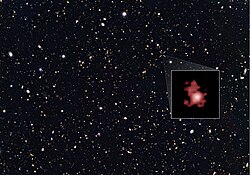References
- ↑ Santerne, A.; Malavolta, L.; Kosiarek, M. R.; Dai, F.; Dressing, C. D.; Dumusque, X.; Hara, N. C.; Lopez, T. A.; Mortier, A.; Vanderburg, A.; Adibekyan, V.; Armstrong, D. J.; Barrado, D.; Barros, S. C. C.; Bayliss, D.; Berardo, D.; Boisse, I.; Bonomo, A. S.; Bouchy, F.; Brown, D. J. A.; Buchhave, L. A.; Butler, R. P.; Collier Cameron, A.; Cosentino, R.; Crane, J. D.; Crossfield, I. J. M.; Damasso, M.; Deleuil, M. R.; Delgado Mena, E.; et al. (2019). "An extremely low-density and temperate giant exoplanet". arXiv: 1911.07355 [astro-ph.EP].
- 1 2 3 4 "HIP 41378 c CONFIRMED PLANET OVERVIEW PAGE". NASA Exoplanet Archive. Retrieved 2016-07-07.


